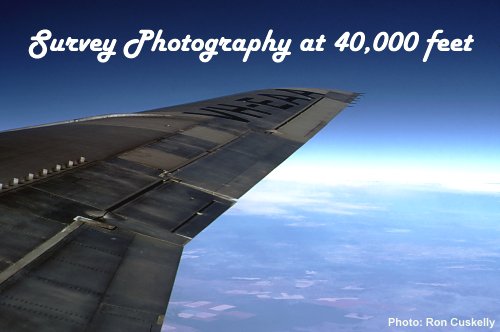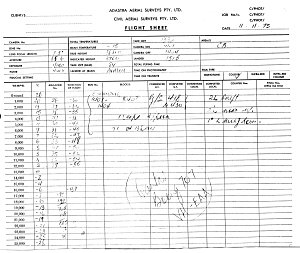|
The quest for
high level, wide angle (RC9) photography (and in colour) began,
in Adastra's case, in early 1973 following a suggestion from the
National Mapping Council, (per Joe Lines). The only 40,000 foot
capable aircraft within Adastra's financial reach was the Hawker
Siddeley HS125. We requested from Qantas and were given relevant
performance figures. We were also able to put the tape measure over
a Qantas HS125 with regard to the physical fitting of the RC9 camera,
(Jack McDonald, our works manager, in charge).
Then in June of 1973, we learnt of an HS125 being on the market.
This was VH-TOM which belonged to a large wholesale grocer "Tom
the Cheap" and which was operating out of Perth. Consequently
I went over to Perth and was given a demo flight on 23rd June 1973.
(Max Garroway, who had been one of Adastra's top survey pilots,
agreed to accompany me on the flight. Max had resigned some years
earlier and was now the W.A. manager for Michelin.)
Before the flight I had given the pilot, a young man named Barclay
Archbold, our requirements for survey operation - mainly to take-off
with full fuel and flight at 40,000 feet true. Before the flight
Barclay was straightforward and told us that, under the conditions
requested, we would be disappointed with the aircraft's performance.
And so it proved to be. The HS125 with full fuel climbed magnificently
to 40,000, but as a survey platform at that weight, was hopeless.
It actually wallowed. Barclay then agreed to my request and we stooged
around until we could ascertain the fuel limitation to enable stable
flight at that height.
In spite of this setback (we would be losing about 30 minutes duration)
it was decided to press on with the investigation. To this end,
East-West Airlines, who were about to take-over Adastra, fabricated
a light weight pattern of the RC9, and David Ham of Qantas designed
a cradle for the camera and its fitment in the rear of the HS125.
However, physical problems with the latter continued and Qantas
suggested switching to the Boeing 707 for the test programme. David
Ham showed that the RC9 could be fitted in a fuselage panel immediately
below the cockpit. This panel gave access to a pressurised compartment
which could also be reached from the navigator's station, behind
the captain's seat. The aircraft chosen for the modification was
VH-EAA and the camera installation was made without problem.
Our first test took place on 20th December 1973. VH-EAA was on acceptance
after a major, and takeoff and landing were both at Mascot. The
weather turned sour during the flight and we ended up over 8/8,
so my only job was to go through the routine of setting up the camera
(i.e. drift, time interval, level) and making sure the on/off was
working. This switch operated by way of an extension lead which
I held in the cockpit.
The flight could have been termed a fizzer but at least the ground
work (literally) had been proven, and all we awaited was another
opportunity both weather-wise and a suitable VH-EAA flight.
Costing, as always, was a major consideration and although N.M.C.
maintained their interest, no contract would be made until Adastra
had produced a sample run. Chartering a 707 was out of the question,
but to help out, Qantas now suggested an economical way of achieving
our aim. Periodically EAA ferried crews to Avalon for training and
we were offered a block of time during the ferry, for our work at
40,000 feet.
However, before a second opportunity arose, EWA, now the owners
of Adastra, seemed to lose interest in the project. There was also
a further small contretemps in that Adastra and I parted company
in May 1974.
Lou Pares, our General Manager, was overseas and in his absence,
being his deputy, I was in charge, but sadly had a serious run-in
with John Riley, the G.M. of EWA. The latter were, no doubt, dab
hands at moving passengers and freight around the countryside, but
knew precious little about air survey. Anyway, my dispute with their
top man was enough to give doubts about the future and I resigned.
Pares, on his return, was determined to regenerate the project and
asked me to act as standby consultant and navigator. This I agreed
to readily, as I was as interested as he.
But it was late in the year before the scheme got underway again,
and no Qantas ferries coincided with survey weather until January
1975, when the first trial since December 1973 occurred. The flight
was moderately successful in that we had produced survey photography
at 40,000 feet. However, the quality of the prints was substandard,
and adjustments to aperture, exposure time, filter and camera heating
were required.
Then over the year another five flights were made with little achieved
(mainly due to a series of camera faults or poor weather) until
the last on 11th November 1975, when good quality survey photography
resulted. My records of the seven sorties are rather scant but below
are listed such details as I retained.
|
20DEC73
|
Sydney
to Sydney |
Nil
photography due weather. |
|
20JAN75
|
Sydney
to Avalon |
Encouraging
result. |
|
17MAR75
|
Sydney
to Avalon |
Nil
photography due weather. |
|
01APR75
|
Sydney
to Avalon |
Camera
u/s. |
|
??JUL75
|
Sydney
to Avalon |
Camera
u/s. (Navigator was Lance Nichols. Self in Brisbane). |
|
02OCT75
|
Sydney
to Avalon |
Camera
u/s and weather unfavourable. |
|
11NOV75
|
Sydney
to Melbourne |
Survey
run over Canberra. |
Some Comments
on the 11th November Flight:
| (a) |
VH-EAA
took-off with full fuel (an error) and was thus overweight for
an Avalon landing, and diverted to Melbourne. |
| (b) |
The
aircraft weight, combined with ATC requirements, meant we had
climbed to only 37,000 feet when Canberra was in view. As Cu
was forming, I decided that a photo result was more important
than the lower altitude and we moved straight on to the run. |
| (c) |
The
target run included Parliament House, which we crossed at 1400EST,
on a day which has gone down as one of infamy in Australia's
constitutional history. |
Postscript:
All our work with its attendant delays and frustrations, was for
nought, as shortly after that last and successful flight, satellite
imagery became readily available.
Mike Wood
February 2003
This article
appeared originally on the Adastra Aerial Surveys website www.adastra.adastron.com
It is
reproduced here with permission.
|




